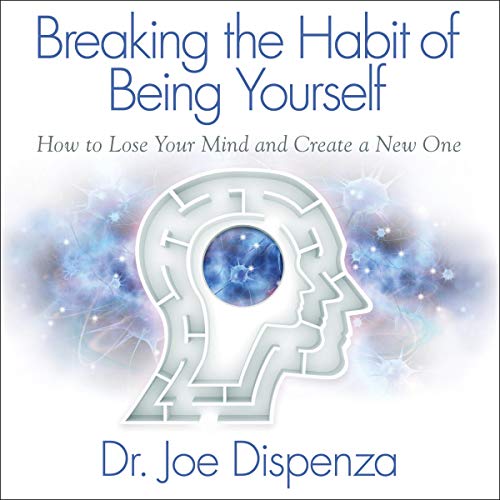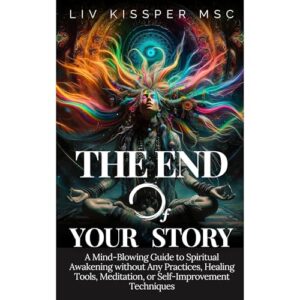Your cart is currently empty!
Breaking the Habit of Being Yourself (Audible Audio Edition): Joe Dispenza, Adam Boyce, Encephalon LLC: Audible Books & Originals
$1.00
No description Share on FacebookShare on TwitterShare on LinkedinShare on PinterestShare on XingShare on Reddit
Description
No description







Jason L. Kessinger –
Changing habits one thought at a time.
This book is a great read for anyone looking to change the way their mind works. It is full of ways to help with getting out of the habit of the mundane everyday living to change your life if that’s what you’re seeking. This book could be just what you’re looking for. I recommend it 100%.
One person found this helpful
JR –
Everything in this book is good n you’ll start to realize it in first 30 pages or so….
Still reading ,but things you need to know or at least be aware of…… read it. I’ve got too many health books going at this time to elaborate ….
Arbi –
amazing book
Made me realize my old programs were hindering me to move forward in life. You need to get a hold of your inner real light and soul and be aware of your truest self and not your past worries and the old personality you created. You are more than that and this what this book helps you realize
3 people found this helpful
Irene –
Breaking the habit of being yourself
Breaking the Habit of Being Yourself* is just one of many transformative books on my self-improvement journey, and it stands out as a powerful guide to personal change. Dr. Joe Dispenza masterfully combines neuroscience, quantum physics, and meditation techniques to help readers break free from limiting thought patterns and design a more conscious, fulfilling life.What makes this book exceptional is its accessible approach to complex concepts, offering both scientific insights and practical exercises. It’s not just about understanding change—it’s about implementing it. As someone committed to growth, I found this book deeply empowering. It reinforces the idea that we are not bound by our past experiences; rather, we have the ability to shape our future through intention and mindful practice.For anyone on a self-improvement journey, *Breaking the Habit of Being Yourself* is an invaluable read. It’s a reminder that true transformation begins within, and with the right mindset, anything is possible.
13 people found this helpful
Kelly Daley –
I love this book.
A friend of mine recommend this book if you looking to break habit and just to be yourself, this book is a must read. I absolutely love it.
Rachael –
Steps to Change One’s Mind
Breaking the Habit of Being Yourself: How to Lose Your Mind and Create a New One is the second bestselling book by Dr. Joe Dispenza. His first book, Evolve Your Brain, explained the concept of neuroplasticity and how one can alter the brain itself based on thought and feeling. As his second best-selling book, Breaking the Habit of Being Yourself, also explores the practice of neuroplasticity. However, rather than just an explanation of neurplasticity, this book goes deeper into the subject of how to actually apply the practice to one’s life, as well as how to achieve the benefits of the science. Dr. Joe Dispenza has a very extensive background in the sciences. He earned his Bachelor of Science with an emphasis in neurobiology from Life University in Atlanta Georgia and went on for his Doctor of Chiropractic. He then went on with postgraduate education studying neurology, neuroscience, brain function and chemistry, cellular biology, memory formation and aging and longevity. Dr. Dispenza currently runs a chiropractic clinic in Olympia Washington while also holding conferences and seminars in order to teach his method of carrying out neuroplasticity all over the world. Not only have his first two books been best-sellers but he was also featured as one of the scientists in the film What the BLEEP Do We Know!?as well as The People vs The State of Illusion. Dr. Joe Dispenza’s extensive background in neurobiology and science resulted in an intriguing book that went very in-depth into not only the science behind neuroplasticity, but also meditations that would allow one to change their own mind. I found the science behind the practice very fascinating and something that could be expanded on, while other parts of the book dragged on at times. However, the book did was very successful at sparking my interest in the subject of neuroplasticity. Neuroplasticity is a subject that is becoming more well-known among people as well as a science gaining momentum in research. It is a subject difficult to comprehend because it goes against many preconceived notions of the world. The book emphasizes that anyone of any age can change what their brain looksm, which is unlike previous longstanding belief that only children still possessed developing brains. However, neuroplasticity goes even further than one may believe. Not only can the brain change at the level of synapses and neurons but it also goes to the depth of genes which can be changed and affected by neuroplasticity. The source of this change takes place due to not only our actions but can also be caused by thought alone. Breaking the Habit of Being Yourself was a much different book than I first believed. While I was expecting to be taught on the subject of neuroplasticity, which I was, the book has a much different focus that just education. The aim of the book is largely as a self-help aimed book, with the goal of aiding readers to change their lives and ending destructive personalities and habits. This is done through the practice of a series of meditations outlined in the book and changing one’s overall perspective on how the brain and body work together. The book is broken into three parts. The first section “The Science of You” explains the background science of neuroplasticity and how it works. It begins at a large base of quantum physics and focuses on how the brain and body are actually 99.999 percent energy rather than actual matter and how this energy behaves. It also goes more into depth about neurobiology and neurotransmitters and how each are closely connected to the body, mind, and experiences. The second part of the book, “Your Brain and Meditation” begin to explain Dr. Joe Dispenza’s method of achieving neuroplasticity. Rather than going into detail about what to do for this meditation, part two actually connects the science from the first part of the book to how the mediation will work in one’s body in order to carry out neuroplasticity. Part three of the book, “Stepping Toward Your New Destiny” really looks at the focus of the book, applying neuroplasticity to your own life. It takes the reader step by step on how to carry-out the change. It also does this on a weekly plan so that within four weeks the reader will know how to meditate and live so that neuroplasticity is possible in their lives. This portion of the book surprised me because of its almost mysticism or religious feel, completely contrasting the science portion. This book makes many connections to neurobiology which I was not pleasantly surprised by. Several different subjects of neurobiology came up in the reading. It beings by explaining neurotransmitters in order for the reader to understand how their thoughts and feelings are connected and then connects this to how synaptic connections are formed in the brain. The book explains the concept that when synapses fire together they wire together, creating habits and on even personalities if fired enough. It then goes into the actual brain physiology and the connection the different parts of the brain perform in relation to one another. Breaking the Habit of Being Yourself was a very interesting read covering neuroplasticity. I found that the book seemed to drag on in several sections, covering a small amount of information in many pages. This resulted in disinterest at several points in the book however, it did so in order for the reader to completely grasp the concepts in the book. By taking the reader step by step, carefully through the process of how to change one’s personality such as in part three of the book, it becomes a process anyone can apply to their own life even if they previously knew little about the subject. What I appreciated most in the book was part one and part two of the book. In the first section, “The Science of You”, Dr. Joe Dispenza goes into detail about how the brain actually creates one’s personality. The book does this by extrapolating on how the mind and body work together and how that energy on a thought can manipulate the body into performing a function. I found this to be the most interesting part of the book because it explained the process so well in relation to the science behind it. If anything I would have appreciated even more of the in-depth science. Part two also relayed some of the science behind the practice but bridged the science of the body and how to apply the science and the aims of the mediations. The third portion of the book caught me by surprise because the mediations seemed very faith based or mysticism based. However, because the science was explained so clearly in how the meditations connect with the purpose, the meditations had a foundation and purpose that was easily to follow.Overall this book was a very intriguing read that introduced a new subject to me that previously I had thought impossible. Dr. Joe Dispenza’s explanation of meditations and the basis of why they work made the book much more interesting to read because I wanted to learn to apply it to my own life. However, what I appreciated the most in the book was the science that explained neuroplasticity. While certain parts of the book could be expanded on and other parts said in briefer statements, in general the book made it easy for any lay person to understand and apply neuroplasticity.
221 people found this helpful
Gabriela –
Amazing
Fantastic
Trina A. Nudson –
A powerful blueprint for personal transformation
Breaking the Habit of Being Yourself isn’t just a book—it’s a wake-up call. Dr. Joe Dispenza combines science, psychology, and spirituality in a way that’s both accessible and deeply transformative. He doesn’t just tell you why you feel stuck—he shows you how to break free.What stood out most to me was the clarity with which he explains how our thoughts shape our reality—and how we can rewire our minds through meditation and intentional focus. His work bridges neuroscience and personal growth, giving readers the tools to shift from living in the past to creating a meaningful future.If you’re ready to step out of your old patterns and into a more empowered version of yourself, this book is a must-read. But be warned—it’s not passive reading. It invites you to do the work, and if you’re willing, the results can be life-changing.
17 people found this helpful
Janan B. –
An honest review of Joe Dispensa’s books and progressive workshops
I purchased this book and participated in a workshop with Joe Dispenza. It seems that his team Encephelon cleans up the Internet with impeccable detail! (no Wiki page, or anything less than flattering anywhere) So what “Joe” dispenses in his new age message is done with a typical motivational marketing team that should be off-putting to the average person with a grain of discernment and a meditation practice.In general, in his last book his newer line of thinking sells the idea that the human mind can change the manifestation of reality and change his fate; all this can be done by a certain personal discipline including meditation. Until now it sits well with the newer current of ideas. I like the idea of meditating and love the idea of manifesting too! About the science facts, I’m not sure, but it sounds interesting and I’m willing to suspend disbelief and try it out.What pains me though, is the method of delivery of this so called Workshop …where there never was a schedule handed out, we were left at the mercy of JD. In particular, he proceeds to claim to have witnessed spontaneous remissions of serious illnesses in his workshops, and I noticed several participants in wheelchairs or on crutches … not counting all the participants with undetectable disease in the hall … these people are especially vulnerable to false hopes that healing is instantaneous and about to happen! At no point does he show any real testimonies of miraculous healings … his anecdotes should suffice to make us believe in a better tomorrow.His workshop was fairly expensive, and it is said that this cost is justified since it included videos (about 5 hours) of a previous workshop that no longer exists but which must be watched before you attend the progressive workshop … the majority of the workshop I attended (progressive) was the verbatim repetition of that video!!! … is it brainwashing? or lack of imagination or information? I would say that this is the recycling of old stock. They also strongly encourage us to read his latest book, Breaking the Habit of Being Yourself, which again a rehash of the same thing? (Enough already!) Even his anecdotes are the same! He seems to have learned his text very well. But don’t expect him to interact directly with the participants; he can’t go off script. He allows no questions from the audience.In addition, the meditations (which I find interesting) of the 2.5-day workshop are the same as those he sells online … but it appropriates some ancient techniques of meditation (among others Kundalini) claiming that enlightenment is imminent and easy to obtain if you follow to the letter his instructions … ex. you have to push the energy of the first chakra to the seventh with forced breath holding – a bit like self-asphyxiation -which can cause particular sensations … pffft!However, I appreciate the fact that he encourages his “disciples” to install a daily meditation practice. But to judge as wrong or right the personal practice of a meditation, and to expect some kind of magical effect is not right. Meditation takes many forms and is individual…and is not a result oriented practice…it should be a journey. Pushing for results is not the way!I especially hated the obvious marketing in the workshop where he plugs advertisements for the upcoming workshops, publications, at all times; and where the electoral campaign/pep rally style is used by encouraging the participants to dance and clap after the breaks to lively music for no apparent reason except to make promotional videos (looks like you’re having fun here -! artificial enthusiasm for a meeting where calm should be nurtured…)I also noticed that JD does not care entirely about our questions on site (you could ask questions at his paying webinars I guess), or our learning (no leader came to guide us, there were no group activities) … he seems to be more interested in our wallet.He also seems to use a type of communication with his technical team by pretending to make us interact (ex. – “poke your neighbor” and “discuss what you understand”) that are not often logical since he did not give enough info for discussion and he obviously seeks a break for some reason … perhaps he needs to blow off some time during these pauses ….or hear his next line in his earbuds.He also makes an unnecessary use of Youtube videos to so-called “spark our enthusiasm and inspire the imagination of our emotions” … I think even here he gets a small break on stage … all these videos were “déjà vu” for any subscriber to FB!Finally, I come out disillusioned and annoyed to have spent to attend a workshop with such manipulation techniques and lack of concern for the participants! I love some of his ideas, and I come out a little more aware of the dangers of this kind of workshop. I have compassion for some of his “fanatical groupies” and even some exalted shouters during the meditations.I hope my reflections and questions will spur discussion or at least “enlighten” a few … I wish I had read this kind of criticism before spending … but I think his team is efficient at digital scrubbing.
4,214 people found this helpful
danielcooley –
The Good, the Bad, and mostly Ugly
I read this book on a recommendation, but I can’t recommend it.The Good:Dr. Joe Dispenza has some great quotes, like: “A memory without the emotional charge is called wisdom.” And, “Change as a choice, instead of a reaction.” I’m sure these quotes, and his desire to help people become better people, has helped folks. But I still can’t recommend this book.That’s because other quotes are closer to Buddhism than realism, and, for me as a Christian, sound like the serpent talking to Eve. For example, “To be empowered—to be free, to be unlimited, to be creative, to be genius, to be divine—that is who you are…. Once you feel this way, memorize this feeling; remember this feeling. This is who you really are….”No, it’s not who I am. It’s not even close. I am not divine. If I were, we wouldn’t have cancer. Or cats. Or ear hair. Speaking of things I don’t like…The Bad:Others have taken the author to task for his “science.” Since I’m no scientist (nor is the author), I’d like to focus instead on the theology being taught, and contrast it with Christianity. Dr. Joe teaches a doctrine of looking within, of focusing on our inner selves to find divine happiness. This is just a short list to demonstrate the contrast of Dr. Joe’s New Age religion to Christianity. Joe teaches that success and joy is within you: P.300 “I fear that this so-called recipe for ultimate success in life has kept us looking outside of ourselves for answers and true happiness, when the real answers and true joy have always been within.” The Bible teaches success and joy come from God, that deceit is within you: Philippians 3:3, “We rely on what Christ Jesus has done for us. We put no confidence in the flesh.” And Psalms 16:11 “You make known to me the path of life; you will fill me with joy in your presence, with eternal pleasures at your right hand.” And Jer 17:9 “The heart is deceitful above all things.” Joe teaches that we can create a new mind for ourselves: p.299 “You are a multidimensional being who creates your reality… you are going to have to lose your mind and create a new one.” The Bible teaches that our minds are transformed by God: Romans 12:2, “Let God transform you into a new person by changing the way you think.” Joe wants you to pray to the Universal Consciousness within yourself for yourself: p.310 “It’s time to turn to the power within you, introduce yourself to it, and tell it what you want to change about yourself… it is real. It already knows you it doesn’t judge you. It only loves. Say to it ‘Universal consciousness within me and all around me, I have been _____ and I ….” The Bible teaches us to pray to the Father through the Son for His will: John 14:13 “And I will do whatever you ask in my name, so that the Father may be glorified in the Son. 14 You may ask me for anything in my name, and I will do it.” Joe teaches that you are God: P. 303 “The greatest habit you will ever create is the habit of expressing the divine through you. That is when you inhabit your true nature and identity. It is to inhabit self.” p.312 “I want you to move into a state of being. It is time to change your energy and broadcast a whole new electromagnetic signature… become it… to be empowered—to be free, to be unlimited, to be creative, to be genius, to be divine—that is who you are.” The Bible teaches that God alone is God: Isaiah 43:10 “Before me no god was formed, nor will there be one after me. 11 I, even I, am the LORD, and apart from me there is no savior.”The Ugly:Much of this book reminds me of Star Wars. George Lucas has been open about borrowing his “Force” ideas from Buddhism and Taoism, as a way of bringing spiritualism into his movies. Dr. Joe Dispenza has not been so open. However, an overview of the schools he has been connected with helps explain where he is coming from. I believe all the information below came from Dr. Joe’s site, Amazon’s book site, the school’s sites or Wikipedia, but there could be sites I don’t remember. I tried to go to original sources, not those upset with Dr. Joe or his teaching.His bachelor’s degree (I never could find what it was in) is from Evergreen State College, his Dr. of Chiropractic is from Life University. But his other connections help to understand the New Age leanings in the book. He is a faculty member at Quantum University in Honolulu, Hawaii. This school’s accreditation is by an organization in India. I know nothing about it, but would guess they don’t serve hamburgers for lunch. The Omega Institute for Holistic Studies in Rhinebeck, New York. This is a non-accredited New Age retreat center. It started from the teachings Eastern meditation teacher, Pir Vilayat Inayat Khan. The Kripalu Center for Yoga and Health in Stockbridge, Massachusetts. According to the interweb, Amrit Desai, who was a disciple of Indian yoga master Swami Kripalu, started the school. It focuses on Yoga and other eastern religious thought. Ramtha’s School of Enlightenment(RSE) is located in Washington state. This school is the most interesting. J. Z. Knight, who claims to channel a 35,000-year-old warrior named Ramtha the Enlightened One, established the school in 1988. I read that, “the school bases its teachings on these channeling sessions.” If so, it would be a helpful place to go if one needed schooling in the art of war in 33,000bc. Joe taught at Ramtha, but doesn’t often mention this school. On the back of this book he highlights the film he was in called “What the Bleep Do We Know!?” which was produced to promote Knight’s teaching. In googling the movie, I read that it got a Pigasus Award for “the media outlet that reported as factual the most outrageous supernatural, paranormal or occult claims.” I have not seen the movie. Their four cornerstones of this school are: 1) The Statement, “You are god.” (I wonder what the real God thinks about that) 2) The mandate to make known the unknown, 3) The concept that consciousness and energy creates the nature of reality, 4) The challenge to conquer yourself.Is Dr. Joe a god? His book forward and website claim postgraduate training in neurology, neuroscience, brain function and chemistry, cellular biology, memory formation, brain imaging, neuroplasticity, epigenetics, psychoneuroimmunology, aging and longevity. I could find no school names or evidence of these claims, but if they are true, and he understands it all, maybe his is a god.I read this book on a recommendation, but I can’t recommend it.
1,420 people found this helpful